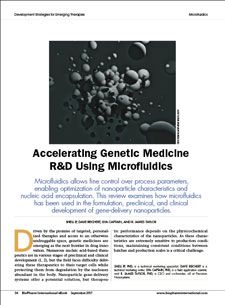Accelerating Genetic Medicine R&D Using Microfluidics
This review examines how microfluidics has been used in the formulation, preclinical, and clinical development of gene-delivery nanoparticles.
Microfluidics is fast becoming an essential tool for encapsulating nucleic acids. Microfluidics allows fine control over process parameters, enabling optimization of nanoparticle characteristics and nucleic acid encapsulation. The continuous, inherently scalable nature of the microfluidic process allows formulations to be optimized at low volumes, before being scaled-up using multiple microfluidic mixers in parallel. This review examines how microfluidics has been used in the formulation, preclinical, and clinical development of gene-delivery nanoparticles.
Download the
BioPharm International’s 2017 Development Strategies for Emerging Therapies eBook.
Article Details
BioPharm International eBook: Development Strategies for Emerging Therapies
Vol. 30
September 2017
Pages: 36-39
Citation
When referring to this article, please cite it as S. Ip, D. Reichert, I. Captain, and R. J. Taylor, "Accelerating Genetic Medicine R&D Using Microfluidics," BioPharm International Development Strategies for Emerging Therapies eBook (September 2017).

